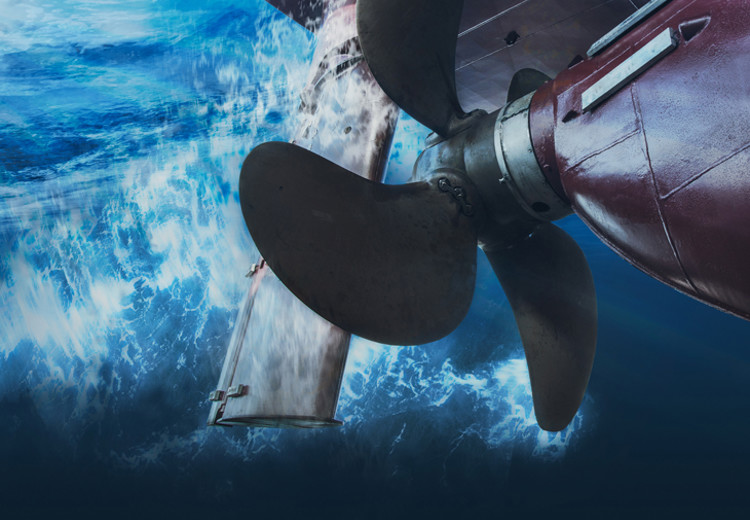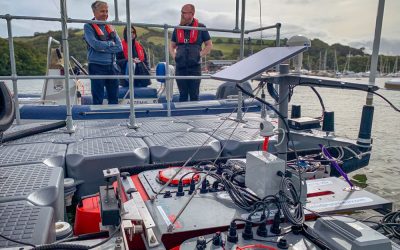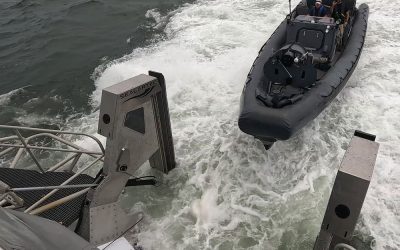Canadian study shows propeller edge deviations increase URN
As any marine engineer or hydrodynamicist can tell you, propeller cavitation is a reality of shipping. But as the causes of anthropogenic underwater radiated noise (URN) fall under increasing scrutiny from environmentalists and regulators there is mounting pressure to develop a deeper understanding of this perennial problem. This has been particularly true in Canadian territorial waters, where under the auspices of Transport Canada the mitigation of URN has led to sponsorship and assistance in a variety of research endeavours.
Last year, a Canada Transport-funded study into the impact of manufacturing tolerances on propeller performance – undertaken by Memorial University of Newfoundland, Defence Research and Development Canada (DRDC) Atlantic Research Centre, and led by Ontario-based propeller manufacturer Dominis Engineering – revealed that even the slightest deviation in propeller geometry can have huge implications for propeller cavitation. With IMO’s Marine Environment Protection Committee (MEPC) due to discuss a draft of its revised URN guidelines at MEPC 80 in July, there are calls for this research to fall under its consideration.
While Computerised Numerical Control (CNC) machining of ship propellers has been in use since the late 1980s, when Bird-Johnson first deployed the technology for the manufacturing of propellers for the US Navy, it’s a technique that’s only really used for rough machining. The overwhelming majority of blades are still laboriously finished using hand grinding, radial arm drills and metal templates, introducing inaccuracies and deviations from the intended design that reduce efficiency and cause cavitation.
It’s also remarkable that commercial ship propellers continue to be manufactured to the same tolerance standard, ISO-484-1, which was formally established in 1981 but originally recommended as far back as 1966, an era when the Wageningen B-series propeller had firmly established its supremacy.
Moreover, ISO-484-1 only measures thickness at seven radial section points, where the leading edge is also measured, and allows for a significant margin of error. The US Navy uses its own ship construction standard, NAVSEA [Naval Sea Systems Command], which is broadly similar, although with a higher number of radial section points on the propeller which have to be measured during an inspection.
Dominis Engineering president Bodo Gospodnetic explains: “For propellers it’s important that the propeller design is optimised for performance inside the wake behind the propeller. Whilst you may have a good design, you have to manufacture it to as close as possible a replication of that design.
‘Hands free’ propeller milling
Unlike traditional manufacturing Dominis Engineering, the company founded by Gospodnetic and his late father in 1985, crafts its propellers without any manual grinding. Convinced that no amount of hand grinding skill can ever deliver the necessary quality, they spent years developing a proprietary process for CNC machining capable of delivering propellers to their final form and finish, as well as new protocols for representation of all propeller surfaces and their edges. These edges are manufactured cord-wise, rather than the more conventional approach of span-wise.
After initially securing contracts to deliver hydro turbines it later secured jobs with the US Navy (USN), which it has been supplying now for some 20 years, including projects such as the USN’s Littoral Combat Ships, as well as naval vessels for other countries. Much of Gospodnetic’s time is now spent engaged upon propeller tolerance research, presenting a paper at SNAME’s Propeller & Shafting Symposium in 2015, but Dominis also has the merchant shipping sector in its sights.
He explains: “It’s important to realise that all propellers will eventually cavitate, whether that’s at 12, 15 or 18 knots. When designing a commercial propeller it’s really a balance between efficiency and cavitation, because the propeller tip is so important when it comes to propeller loading… What we’ve done at Dominis Engineering is say forget about the standard, let’s see what kind of precision we can really achieve.”
Cavitation can be divided into three categories: bubble cavitation, which can be managed by changing a propeller’s geometries so that it only occurs above a vessel’s top speed; sheet cavitation, which occurs at locations along the leading edge; and vortex cavitation, which typically begins at the propeller’s tip and hub and trails downstream. The latter is usually the first type of cavitation to form and has the lowest cavitation inception speed.
Despite their shortcomings, both the ISO And NAVSEA standards place an emphasis on the leading edge. Although the ideal is for a curved outline, the grinders used for finishing can often cause flat spots that compromise this. Another possible cause of damage to the leading edge can be cleaning of fouling from the propeller during maintenance.
Research project
For the study undertaken by Dominis and its project partners a propeller blade from an in-service Royal Canadian Navy vessel, HMCS Nipigon, was examined for defects. This identified a sharp-edged flat adjacent to the leading edge which deviated by 0.5mm from the ‘as designed’ form, at the limit of tolerances permitted by ISO-484.
Using Reynolds Averaged Navier-Stokes (RANS) CFD, researchers at the DRDC-Atlantic Research Centre, and Memorial University of Newfoundland, ran simulations for sections of the propeller blade both for the ideal geometry and leading-edge defects of 94µm, 250µm and 500µm.
Meanwhile, physical experiments of cavitation inception on these sections were conducted in a cavitation tunnel using 2D foil model, incorporating sections both ‘as designed’ and ‘as built’ (containing the same flawed surface as the original propeller blade). These had been CNC milled from solid blocks of aluminium to ‘final form and finish’ using Dominis’s own ‘hands off’ process and laser scanning of the models found them to be accurate to within +/- 0.100mm (+/- 0.004inch). Minimum pressure coefficients and cavitation numbers were developed and measured over a variety of different angles of attack.
The CFD calculations predicted that a typical propeller blade section with a 0.5mm defect on the leading edge would result in a narrower cavitation bucket, indicating that such defects have the potential to cause much earlier cavitation on propellers. But perhaps the more dramatic results were the contrast between the perfect and defective physical models of the typical propeller blade section, where the loss in cavitation inception speed caused by a 0.5mm leading edge defect was found to be as much as 35%. In other words, to avoid cavitation the vessel would need to drastically reduce its speed compared to a propeller without those flaws.
Next steps
Having identified and demonstrated the problem, Gospodnetic and the Dominis Engineering team are now busily engaged in further investigations. He explains: “We originally planned for this research to have four different parts: Phase 1 was the two-dimensional propeller section with a rectilinear flow with defects on the leading edge which hinder tolerance. I repeated the experiments which we conducted for Transport Canada and expanded it to two more types of defects – just in case that was a fluke – and the trend was the same.
“The next part will be to see what is the impact of these leading edge defects on the tip vortex cavitation and the impact on the leading edge vortex. Does this defect precipitate the tip vortex cavitation? We plan to do this in what I call a wing plan form of a propeller blade, where you have all the sections but they are de-pitched so you have a 100% rectilinear flow.
“The third phase would be to do this in a full-size propeller. Two propellers, one that is manufactured as best as possible and the other with defects on the leading edge, and run it on the ship sea trials with cavitation observations from the inside of the hull. We’re hoping to get this going together with Defence Research and Development Canada for a propeller that’s less than 2.5m, with a fourth phase for propellers greater than 2.5m.”
However, he remains concerned that some of the findings may be swept under the carpet by those who would sooner propeller tolerances weren’t held to such exacting (i.e. potentially more expensive) standards.
“Nothing’s going to happen until IMO tells shipowners it may cost them but they have to do it if they want a licence,” he warns.




